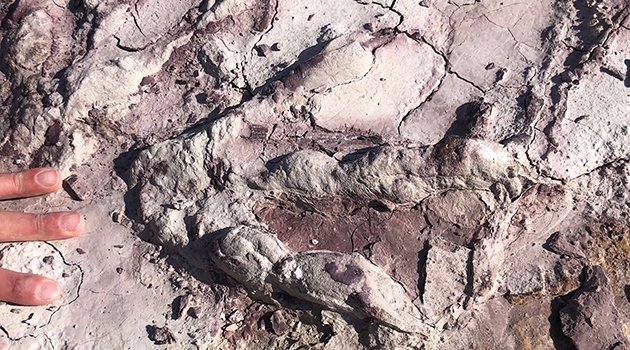Previously unknown dinosaur habitat found in Poland
In summer 2021, in an opencast clay mine in Borkowice, Poland, researchers found what may be Europe’s largest array of dinosaur tracks. Several hundred very well-preserved footprints from at least seven dinosaur species were discovered, and the scientists say far more remain to be found.
“Ultimately, I think thousands of dinosaur footprints will come to light. We’ve also found some skeletal parts. But it’s worth noting that exploration of this site has only just begun, and we’ve mainly concentrated on safeguarding the now exposed blocks with dinosaur tracks. We’ve also got tracks of other animals, like small crocodiles and early mammals, that ran around the dinosaurs’ feet,” says geologist and palaeontologist Grzegorz Niedzwiedzki of Uppsala University’s Department of Organismal Biology.
saur species have been found in Borkowice.
Photo: Grzegorz Niedzwiedzki
Some footprints are so perfectly preserved that the reptilian skin and claws, for example, are distinguishable in detail despite being 199 million years old. Back then, dinosaurs ambled around the area, which was then a coastal strip beside a shallow sea. The climate was warmer than today’s, and river mouths formed a delta there. Conditions for life were good, and factors enabled immortalisation of the animals’ footprints on the muddy ground.
There is nothing unique about finding dinosaur tracks, as such – it has been done in numerous places. What distinguishes Borkowice is that the footprints are so exceptionally old: they date from the very beginning of the Early Jurassic geological epoch.
“It’s an extremely interesting period for researchers – one in which dinosaurs were the dominant terrestrial vertebrates and their dynasty was beginning. Worldwide, few sites have well-preserved remains of dinosaurs from that epoch,” Niedzwiedzki says.
Several orders of reptiles
The excavation site in Borkowice measures only some 200 square metres [2,150 square feet], but the stratum that the scientists have been studying contain some 10 dinosaur footprints per m2 [approx. 10.76 sq. ft]. The researchers cannot yet say exactly which species trod here, but the presence of several orders of reptiles is entirely clear.
“The site had an extremely complex dinosaur fauna, as he tracks show. They were made by dinosaurs running, swimming, resting or lying on the muddy ground. Based on these well-preserved footprints, we’re going to be able to reconstruct the animals, and possibly also describe completely new species previously unknown to science. Besides herbivore footprints, there are tracks of predatory dinosaurs in which the claws stand out amazingly well. The biggest footprints of predatory dinosaurs found in Borkowice so far are nearly 40 centimetres [15.75 inches] long, probably made by individuals that may have been up to 6 metres [19.69 feet] in length.”
More to find
Niedzwiedzki believes that scientists will be able to make new discoveries at the site over the next ten years or so, and that the material already collected is itself a source of new knowledge.
ment of Organismal Biology in Uppsala.
“We’ve already started investigating the material, of course. We’ve 3D-scanned some footprints and we’re trying to learn more about the processes that enabled the tracks to be preserved. And the material collected contains new fossils that haven’t been described in Poland or Europe before, so it’s all hugely exciting.”
Åsa Malmberg

